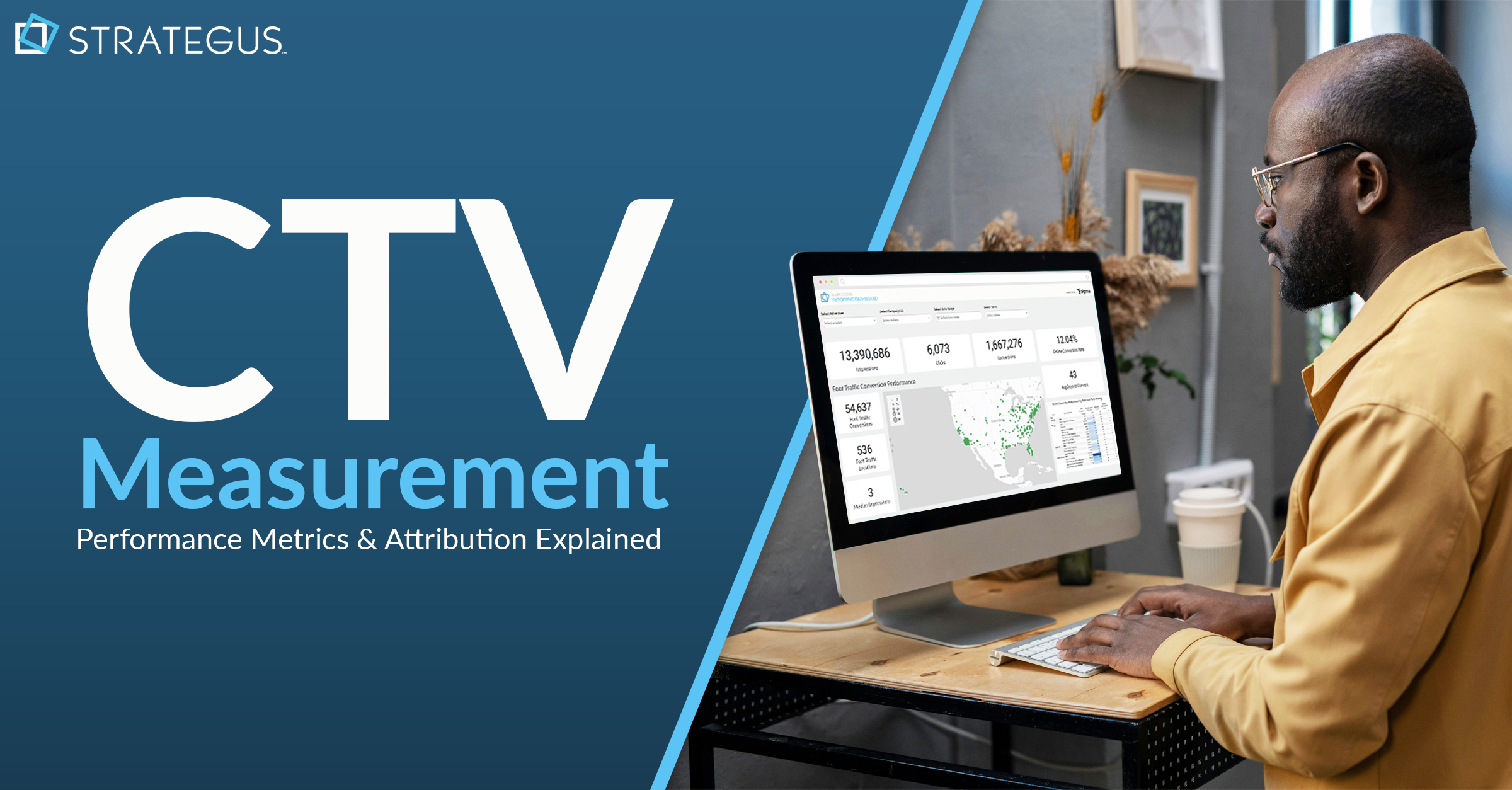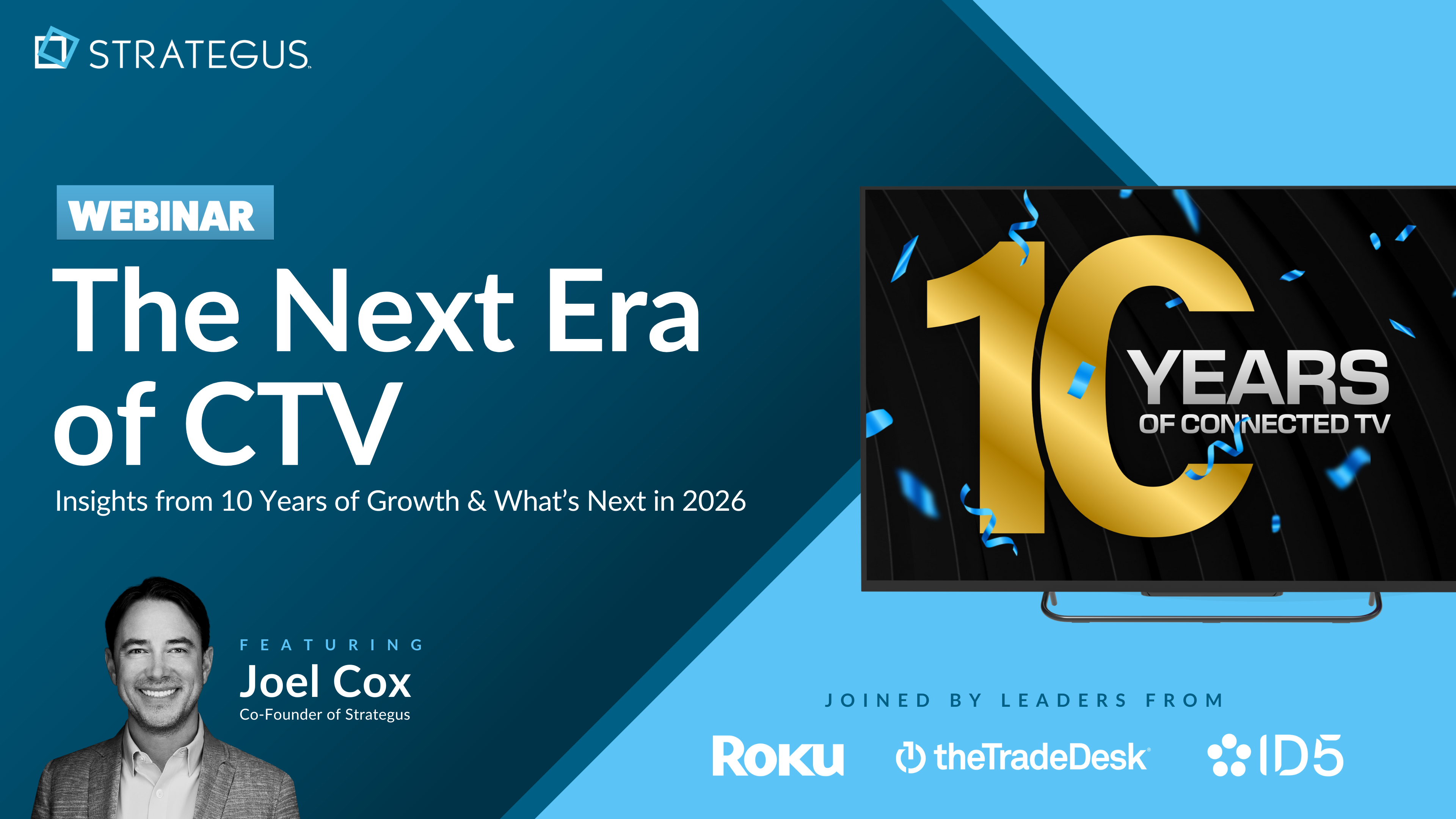- Home
- Strategus Blog
- CTV Measurement: How to Track Performance, ROI and Attribution
CTV Measurement: How to Track Performance, ROI and Attribution
 Traci Ruether
Traci Ruether
14 minutes read

One of the biggest differences between traditional TV advertising and delivering ads to connected TV (CTV) devices is that the latter can be measured with precision.
With CTV, you know exactly who saw your ad, what they did next, and how it drove results. This guide covers how to track performance, measure ROI, and attribute conversions, so every impression counts.

Key Takeaways
- CTV enables precise, outcome-based tracking across impressions, VCR, clicks, conversions, and ROAS; not just reach.
- Advanced attribution connects ad exposure to online purchases, foot traffic, and CRM revenue via privacy-safe identity graphs.
- Audience, device, and genre reporting surfaces performance gaps; frequency and daypart insights reduce waste.
- Cross-device retargeting and programmatic buying make TV a full-funnel engine with measurable ROI.
- Incrementality tests and creative-level breakdowns validate impact, refine messaging, and scale winners confidently.
- Strategus provides a leading CTV attribution suite; real-time dashboards, revenue pixels, GPS footfall, and fully managed optimization. Speak to a Strategus expert to learn more today.
What is CTV Measurement?
CTV measurement is the process of tracking and analyzing the performance of connected TV campaigns across key metrics and outcomes. It starts with monitoring basics like impressions and video completion rates to make sure campaigns are hitting reach and frequency goals.
With advanced tools like multi-touch attribution and retargeting, Connected TV measurement goes further, capturing actions like website visits, online purchases, and foot traffic. This allows marketers to evaluate real-world impact, compare performance across segments, and continuously optimize campaigns for better results.
Standard Performance Metrics You Should Track
Here’s a look at the most common CTV KPIs and how they might inform your approach.
1. Impressions
This metric tells you how many people saw at least a portion of your CTV ad. Although it’s more of a vanity metric in that it doesn’t quantify revenue, it still tells a lot about the reach of a given campaign.
2. Completion rate
The video completion rate is often high in CTV advertising because the ads are non-skippable and play within user-selected content. For this reason, VCR is more useful for detecting major trends that would indicate an issue, as well as for monitoring completion rates across other streamable channels like online video and streaming audio.
3. Clicks
When running omnichannel CTV campaigns that use retargeting tactics across clickable media like search, display, online video, and more, you’ll want to measure how many clicks are generated. This is a straightforward count of the number of times users clicked on your ads to learn more.
4. Click-Through Rate (CTR)
Click-through rate measures the number of clicks per impression. While the CTR will generally be low, any increase indicates that your efforts are resonating with viewers and driving action. This metric should always be considered in terms of the goal and channel. An awareness ad won’t have a high click-through rate, nor will a CTV ad that lacks clickable elements.
5. Conversions
This metric focuses on the specific actions taken by viewers as a direct result of seeing your CTV advertisement. Depending on your campaign, a conversion might mean that the viewer filled out a contact form, made an online purchase, or stepped foot into brick-and-mortar locations.
6. Conversion Rate
The conversion rate measures the percentage of users who’ve completed a desired action by dividing conversions by impressions. These actions are tied directly to attribution capabilities, which is why we dive deeper into attribution below.
How to Measure CTV Advertising
Measuring the effectiveness of a CTV campaign starts with tracking performance across key metrics that align with your goals, whether it’s reach, engagement, conversions, or ROI. Here’s how to approach CTV measurement:
1. Start with Core Performance Metrics
These are standard KPIs that tell you how your ad is performing at a high level. These metrics are impressions, competition rate, clicks, CTR, etc. We’ve already talked about them and their significance in measuring performance.
2. Use Advanced Attribution Models
CTV's measurement capabilities go beyond basic metrics to prove real business impact. The right attribution model depends on your campaign goals, whether that's driving immediate online conversions or influencing in-store purchases weeks later. The CTV platforms we have right now offer sophisticated tools that connect ad exposure to customer actions across both digital and physical channels.
Here's how to make the most of these advanced attribution models:
- Multi-Touch Attribution: Tracks how CTV ads contribute across the buyer’s journey.
- Online Conversion Tracking: Links ad views to actions like purchases or form fills.
- Offline Attribution: Measures foot traffic or in-store sales using IP-level or device-level data.
3. Track Audience Behavior
Audience behavior data is extremely valuable for A/B testing and all your future campaigns. Every segment of your audience will interact with your ad in a slightly different way. Knowing this information can push your next campaign way past the current one. You can track audience behavior through:
- Demographic Performance: Measure how age, income, or household traits impact results.
- Frequency Analysis: Understand how many exposures drive action without causing fatigue.
- Dayparting Insights: Identify when your audience is most receptive by analyzing performance across different times of day and days of week, then optimize your flight schedule accordingly.
4. Compare Across Devices and Channels
CTV's fragmented ecosystem means your ads appear everywhere from Roku devices to PlayStation consoles, each with distinct viewing behaviors and engagement patterns. These performance variations matter and they help you allocate budget more effectively and negotiate better deals with specific publishers. Break down performance by:
- Device Type: Know where your ads perform best. Smart TVs often drive higher completion rates while mobile CTV can offer better click-through rates.
- Channel/Publisher: Identify top-performing inventory sources to double down on winners and cut underperformers.
- Content Genre: Analyze how your ads perform alongside different programming types, from live sports to true crime, to refine your contextual targeting strategy.
5. Tie Performance to Business Outcomes
Impressions and completion rates tell only part of the story. The real measure of CTV success is its impact on your bottom line. Modern measurement platforms can connect the dots between ad exposure and revenue, providing the ammunition you need to justify and scale your CTV investment. Where possible, connect media exposure to actual ROI:
- Cost Per Acquisition (CPA): Track the true cost of acquiring customers through CTV versus other channels.
- Return on Ad Spend (ROAS): Calculate revenue generated per dollar spent to optimize budget allocation.
- Sales Lift or Brand Lift Studies: Conduct controlled experiments to measure incremental impact on sales volume or brand metrics like awareness and consideration.
How to Get More Granular With Analysis and Reporting
With any digital ad campaign, engagement metrics are important to watch. But to move from passive campaign monitoring to proactive analysis and optimization, you’ll want to dive deeper.
How? A good place to start is by examining analytics related to specific variables like audience segments, creative elements, and ad placements.
Here are some of the CTV reporting capabilities that brands and agencies might prioritize to that end:
 Audience Segment: Compare metrics across audience groups to see how your message is resonating with different viewers and where there’s room for improvement. For instance, if a university finds that ads targeting individuals over age 40 aren’t converting well, they may consider adapting the creative to better resonate with that segment.
Audience Segment: Compare metrics across audience groups to see how your message is resonating with different viewers and where there’s room for improvement. For instance, if a university finds that ads targeting individuals over age 40 aren’t converting well, they may consider adapting the creative to better resonate with that segment.
 Geoperformance: Analyze campaign performance across different geographic regions and determine which locations you’d like to invest more budget.
Geoperformance: Analyze campaign performance across different geographic regions and determine which locations you’d like to invest more budget.
 Campaign Comparison: Compare two slightly differentiated campaigns to pinpoint areas for improvement and identify high-performing strategies that can be replicated. For example, a retailer might compare two holiday campaigns to see which one generated more online sales or in-store visits.
Campaign Comparison: Compare two slightly differentiated campaigns to pinpoint areas for improvement and identify high-performing strategies that can be replicated. For example, a retailer might compare two holiday campaigns to see which one generated more online sales or in-store visits.
 Device-Level Reporting: Understand which devices your audience is using to view your ads. Device-level reporting allows you to measure ad performance across screens, ensuring that your creative is optimized for different viewing experiences.
Device-Level Reporting: Understand which devices your audience is using to view your ads. Device-level reporting allows you to measure ad performance across screens, ensuring that your creative is optimized for different viewing experiences.
 Strategy Breakdown: Analyze the effectiveness of different cross-channel tactics, exposure frequencies, and more by examining different strategies. A travel agency, for instance, might find that retargeting viewers with display ads leads to higher conversion rates than online video and streaming audio, and rework their campaign accordingly.
Strategy Breakdown: Analyze the effectiveness of different cross-channel tactics, exposure frequencies, and more by examining different strategies. A travel agency, for instance, might find that retargeting viewers with display ads leads to higher conversion rates than online video and streaming audio, and rework their campaign accordingly.
 Creative-Level Breakdown: See how subtle variations in ad creative impact performance. Measuring the performance of individual ad variations helps you find out the creative elements that your audience relates to the most. Even small changes like reworking the calls to action (e.g., "Order Now" vs. "Get Started") may drive vastly different results.
Creative-Level Breakdown: See how subtle variations in ad creative impact performance. Measuring the performance of individual ad variations helps you find out the creative elements that your audience relates to the most. Even small changes like reworking the calls to action (e.g., "Order Now" vs. "Get Started") may drive vastly different results.
How Multi-Touch Attribution Shows the Full CTV Journey
While detailed reporting and analysis offer valuable insights into specific campaign elements and their performance, these approaches to measurement don't always reveal the full picture of how CTV ads contribute to conversions.
After all, connected TV ads rarely convert in real-time. To truly understand the impact of your CTV campaigns, you need to connect the dots between initial ad exposure and eventual conversions. This is where multi-touch attribution comes in.

How CTV Attribution Works
Traditional TV offers vague signals like traffic spikes, but it can’t track individual conversions or long sales cycles.
CTV allows for granular attribution, revealing every touchpoint from ad view to purchase.
Before launch, define which actions to track. Online brands may focus on purchases; local retailers might prioritize foot traffic. Attribution should align with your goals.
Here’s a look at how marketers can gain insight across these unique paths to purchase when running CTV campaigns.
- Attribution Modeling: A customized attribution model is designed to align with specific business goals and the customer journey. This model analyzes real-time data to understand the contribution of each touchpoint leading to a conversion.
- Ad Delivery: When CTV ads are served, the viewer's IP address is used to create an identity graph, linking various household devices associated with that user, such as laptops, phones, PCs, and tablets. This enables cross-device tracking of the user's journey.
- Online Data Capture: When someone in that household interacts with the brand (visiting the website, making a purchase, etc.), that data is captured for marketing attribution. CRM data, in-house feedback, and pixels all help make sure that relevant touchpoints are tracked.
- Offline Data Capture: In-store visits or purchases, can also be measured using GPS data to measure the number of viewers who visit physical locations after being exposed to an ad or SKU-level purchase data to attribute sales back to a CTV campaign.
- Measurement and Reporting: Insights from attribution analysis can then be used to continuously optimize campaigns. Look for a CTV partner that provides detailed reports on engagement across various audience segments and locations, as well as a real-time reporting dashboard to track metrics like conversion rate and ROAS.
Benefit From the Most Advanced Attribution Suite in CTV
Learning more about the entire buyer’s journey is incredibly valuable when it comes to quantifying ROI and driving better results.
Strategus EVP and Co-Founder Joel Cox elaborates:

So what’s so special about the Strategus attribution suite? In a sentence: we offer the largest suite of customizable attribution solutions in the industry, and it’s continuously growing.
1. Understand the Impact of Your Ads
- After-Ad Influence: Your CTV ads create ripple effects beyond the initial view. By tracking URLs and keywords used in online searches immediately following ad exposure, you can measure how effectively your spots drive viewers to actively research your brand.
- Brand Lift: Campaign success goes beyond direct response metrics. Brand lift studies reveal how CTV shifts the needle on key metrics like awareness, favorability, and purchase intent, giving you the full picture of your campaign's impact on brand perception.
- Post-View Website Visitation: The journey from couch to click is now measurable. Track how many viewers search you up online after seeing your brand on the big screen, quantifying CTV's role in driving qualified traffic to your website.
2. Connecting Online and Offline Behavior
- Foot Traffic: Modern attribution leverages smartphone GPS data to connect ad views with in-store visits. This capability lets you measure the real-world impact of your CTV campaigns, proving how TV drives customers through your doors.
- Online Purchases: Measurement tools at your disposal right now can show the full path from ad impression to online checkout. This end-to-end visibility allows you to attribute sales directly to your CTV efforts, providing clear ROI insights that justify your media investment.
- Retail Media: For consumer packaged goods brands, SKU-level purchase data bridges the gap between online ads and offline purchases. These integrations connect CTV exposure to in-store sales, solving attribution challenges that have plagued CPG advertisers for decades.
3. Advanced Attribution for Deeper Insights
- First-Party Data Matching: Your proprietary customer data becomes even more powerful when integrated with ad exposure files. This matching reveals how CTV impacts your existing customer base while measuring new customer acquisition, even allowing you to assign a dollar value to each new customer gained.
- Revenue Pixel: Precision tracking means knowing exactly what your campaigns generate. Revenue pixels capture the exact dollar amount associated with each online purchase attributed to your CTV campaign, moving beyond conversion counting to actual revenue measurement.
- Search and Social Impact: CTV's influence extends across your entire media mix. Advanced measurement reveals how TV advertising lifts performance in your search and social campaigns, uncovering the hidden multiplier effect that makes CTV a powerful driver of cross-channel conversions.
Turn CTV Data Into Real Business Outcomes With Strategus

Every business is different. That's why at Strategus, we go beyond just providing data. As a fully managed CTV advertising partner, we handle everything from campaign setup to daily optimization; no self-serve platforms or steep learning curves required.
Our team of dedicated account managers and AdOps specialists work as an extension of your team, combining the industry's most comprehensive attribution suite with our 24/7 reporting dashboard to deliver a personalized strategy designed to achieve your specific goals.
Whether you're an agency looking for white-label CTV capabilities or a brand ready to scale beyond traditional TV, we provide the expertise and infrastructure you need without the overhead. Our cross-device retargeting ensures your CTV campaigns seamlessly connect with viewers across all their screens, while our partnerships with 200+ premium publishers guarantee your ads run alongside quality content.
The result? You get maximum return on investment through our team's ongoing optimizations, a complete picture of your customer journey from TV screen to conversion, and the numbers to back it up, all without hiring an in-house programmatic team or navigating complex ad tech on your own.
Get a sneak peek of our reporting dashboard and discuss your attribution needs. Contact a Strategus expert to learn more today!
Frequently Asked Questions
How Can I Measure the ROI of TV Advertising?
To measure ROI, track ad impressions, conversions, and revenue tied to CTV exposure. Use attribution tools like revenue pixels and CRM matching to connect viewer actions to purchases. ROI = (Revenue from CTV ads – Ad Spend) ÷ Ad Spend. Choose platforms with real-time dashboards and advanced attribution.
How Do You Measure the Performance of a TV Advertising Campaign?
Use metrics like impressions, video completion rate, CTR, and conversions. Then, go deeper with attribution models to track how ads influence online and offline actions. Segment by audience, device, or location to see which combinations deliver the best results.
What Are Typical Media Metrics for CTV?
Common CTV metrics include impressions, video completion rate (VCR), clicks, CTR, conversions, and conversion rate. Advanced metrics include store visitation lift, revenue per conversion, and cross-device engagement. Use these to measure reach, engagement, and ROI.
How Do You Measure Store Visitation Lift From CTV Campaigns?
Track foot traffic using mobile GPS data. After a CTV ad airs, location signals from smartphones show how many viewers visited your store. This helps you link real-world visits to specific ad exposures and optimize based on geography.
How Is the Effectiveness of CTV Advertising Measured?
Effectiveness is measured by combining performance metrics (VCR, CTR, conversions) with attribution data that connects CTV impressions to real-world outcomes. The best measurement strategies also show lift in search, social, and in-store activity after a viewer sees your ad.
How Do You Evaluate Different CTV Creatives for Performance?
To evaluate different CTV creatives for performance, use creative-level reporting to test different ad versions. Track completion rate, CTR, and conversion rate for each version. See which visuals, CTAs, or messages perform best. Use the data to refine creative strategy and scale the top performers.
How Do You Track Cross-Device Conversions From CTV Ads?
To track sross-device conversions, identity graphs that match smart TVs to other devices in the home. If someone sees your CTV ad and later visits your site on a phone or makes a purchase on a laptop, attribution links that action back to the original ad.
How to Measure Incremental Lift From CTV Advertising?
To measure incremental lift from CTV advertising, use control groups and exposed groups to compare performance. Look at increases in web traffic, sales, or store visits among viewers who saw the ad versus those who didn’t. This shows the added value (or lift) generated by your campaign.
What is CTV Conversion Measurement?
CTV conversion measurement connects ad views to actions like purchases or sign-ups. It tracks which viewers completed desired outcomes after seeing your ad. Methods include pixel tracking, CRM data matching, and point-of-sale integration for offline purchases.
Can You Recommend CTV Platforms With Strong Measurement Capabilities?
Strategus offers full-funnel measurement, cross-device attribution, and 24/7 reporting. Tatari provides strong incrementality analysis. Innovid supports creative performance tracking. Strategus stands out for its advanced attribution suite, GPS-based foot traffic tools, and real-time revenue tracking for deeper business insights.

Traci Ruether is a content marketing consultant specializing in video tech. With over a decade of experience leading content strategy, she takes a metrics-driven approach to storytelling that drives traffic to her clients' websites. Follow her on LinkedIn at linkedin.com/in/traci-ruether or learn more at traciruether.com.
Strategus is a managed services connected TV(CTV) advertising agency with over 60,000+ campaigns delivered. Find out how our experts can extend your team and drive the result that matter most.
Talk to an Expert
Table of Contents
Seeking a Custom CTV Strategy That Delivers?
What to read next
App Event Tracking: Tie Mobile App Activity to CTV Campaigns
Let’s say you’re running a CTV campaign for a personal finance app.
5 minutes read

Stop Guessing Who Your Audience Is — Let Their Apps Tell You
Connected TV (CTV) targeting often falls in one of two camps.
8 minutes read
See Who Bought After Your Ad + How Much They Spent
You can’t improve what you can’t measure. And for years, that’s been a major problem with TV advertising.
4 minutes read

First-Party Attribution: Match Ads to Sales With CRM Data
The value of first-party data continues to grow.
7 minutes read















